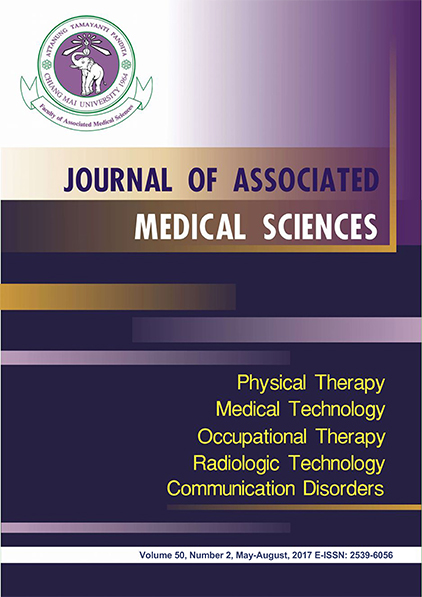The method for classification of noise in computed radiography image
Main Article Content
Abstract
Introduction: Nowadays, conventional X-ray images are replaced by digital X-ray imaging, such as computed radiography (CR) images. Advantages of digital X-rays are, for example, the images can be easily viewed, duplicated and stored. The obtained images can be scaled, measured, compared and adjusted for brightness and contrast, thus enhance diagnosis performance. However, image noise is a key factor that reduces quality of X-ray images. It sometimes causes a deficiency in images leading to misdiagnosis.
Objectives: To classify the noise type in CR images by Naïve Bayes algorithm.
Materials and methods: Firstly, an original image was created for the study. Secondly, a number of instances were created. Each instance was constructed by overlaying various levels of known-noise over the original image. Here, the Gaussian, Poisson and impulse types of noise were considered. Also, the features, mean, SD, MSE, and PSNR were extracted from the modified CR images in this step. Thirdly, the most effective features were selected for classifying type of noise. Fourthly, models were built and evaluated. Finally, noise type in CR image was determined according to the model.
Results: The study was evaluated for classifying noise in CR image, which had 90% correctness.
Conclusion: The study showed that noise in CR system was Poisson noise with precision of 0.95, the recall of 0.73, and the F-measure of 1.13.
Journal of Associated Medical Sciences 2017; 50(2): 275-285. Doi: 10.14456/jams.2017.27
Article Details

This work is licensed under a Creative Commons Attribution-NonCommercial-NoDerivatives 4.0 International License.
Personal views expressed by the contributors in their articles are not necessarily those of the Journal of Associated Medical Sciences, Faculty of Associated Medical Sciences, Chiang Mai University.
References
2. Gonzalez RC, Woods RE. Digital image processing. 2nd Massachusetts: Addison-Wesley; 1992.
3. Goodman JW. Statistical optics. New York: John Wiley & Sons; 2000.
4. Bayes T, Price R. An essay towards solving a Problem in the Doctrine of Chances. By the late Rev. Mr. Bayes, F.R.S. Communicated by Mr. Price in a Letter to John Canton A.M.F.R.S., Philosophical Transactions of the Royal Society of London 1763; 53: 370-418.
5. Leads Test Objects. TOR CDR Radiography Phantom [cited 2016 November 20]. Available from: http://www.leedstestobjects.com.
6. MathWorks. MATLAB R2012a [cited 2016 November 20]. Available from: http://www.mathworks.com.
7. The University of Waikato. WEKA (Waikato Environment for Knowledge Analysis) [cited 2017 February 27]. Available from: http://www.cs.waikato.ac.nz/ml/weka.
8. Papoulis A. Probability, random variables, and stochastic processes. 3rd New York: McGraw-Hill; 1991.


